Human Resource Management Report: Global Business Expansion Strategy
VerifiedAdded on 2023/01/13
|17
|4709
|77
Report
AI Summary
This report provides a comprehensive analysis of Human Resource Management (HRM) practices within the context of a global business expansion, using Merrill Lynch as a case study. It delves into the core functions of HRM, including workforce planning, recruitment and selection strategies, and the importance of employee relations. The report explores the strengths and weaknesses of various recruitment approaches, the benefits of HRM practices for both employers and employees, and the impact of these practices on productivity and profitability. It also examines the key elements of employment legislation and their influence on HRM decision-making. The report concludes with an application of HRM practices to real-world scenarios, offering insights into effective human resource management in a globalized business environment. The report also covers topics such as training and development, performance management, and reward systems.
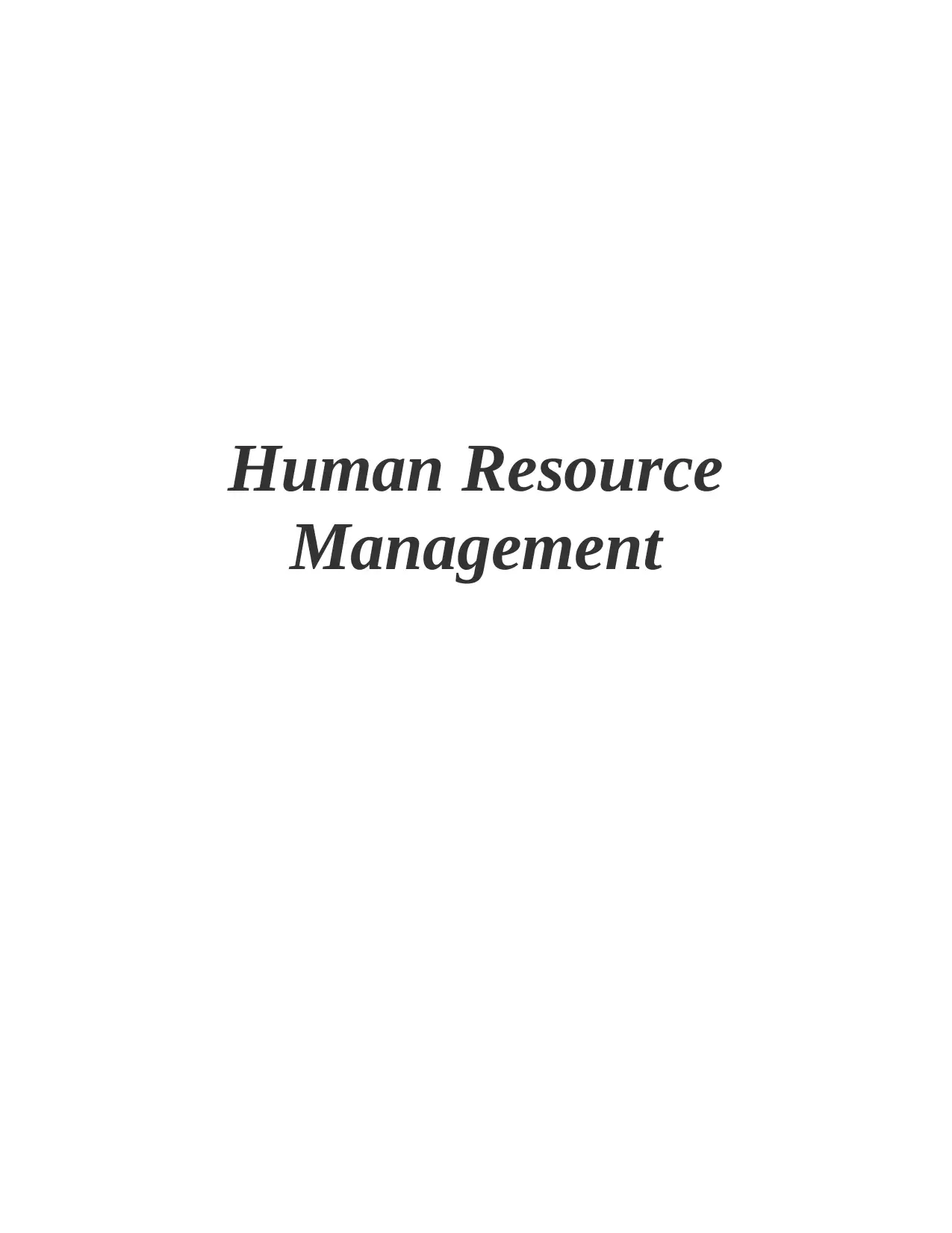
Human Resource
Management
Management
Paraphrase This Document
Need a fresh take? Get an instant paraphrase of this document with our AI Paraphraser
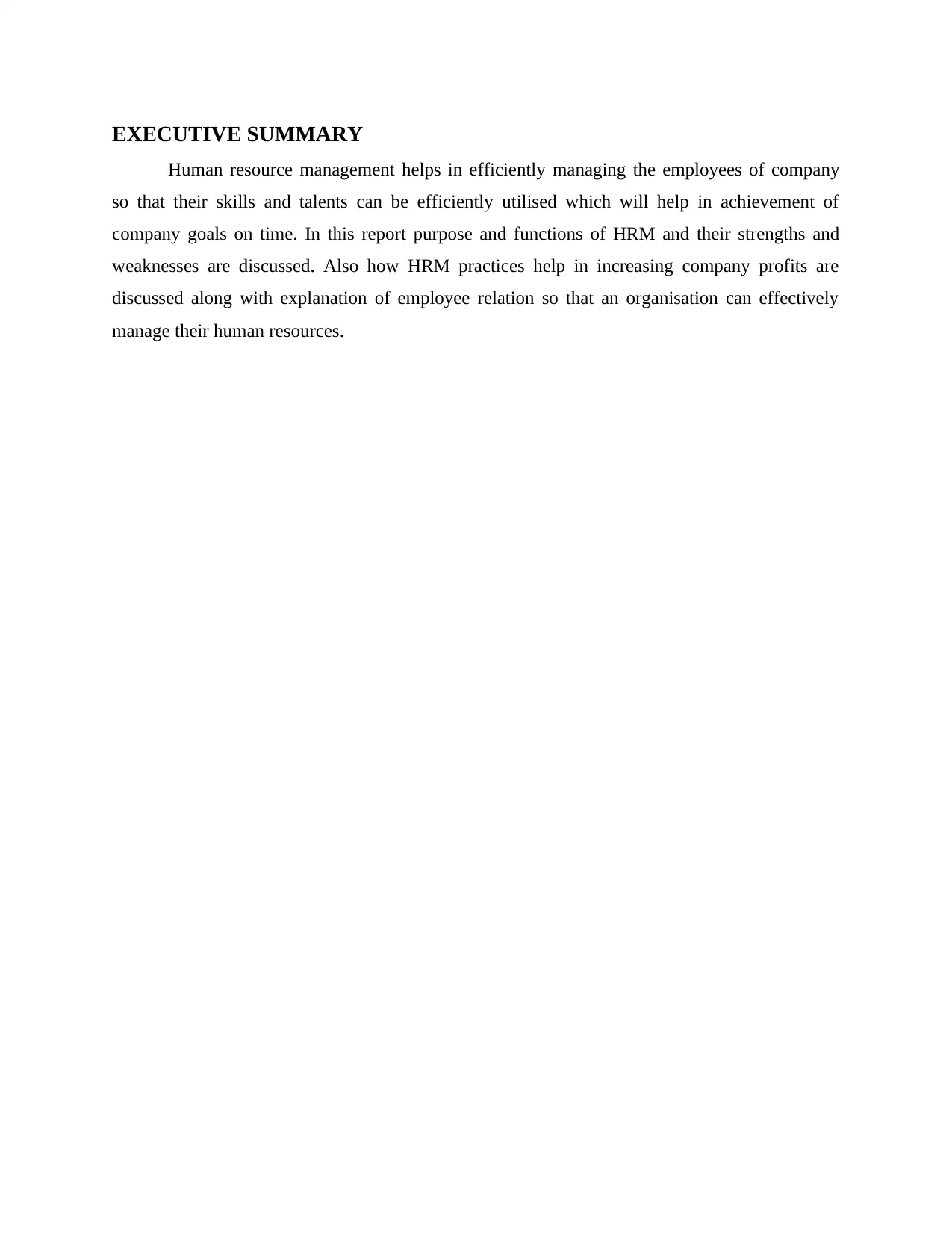
EXECUTIVE SUMMARY
Human resource management helps in efficiently managing the employees of company
so that their skills and talents can be efficiently utilised which will help in achievement of
company goals on time. In this report purpose and functions of HRM and their strengths and
weaknesses are discussed. Also how HRM practices help in increasing company profits are
discussed along with explanation of employee relation so that an organisation can effectively
manage their human resources.
Human resource management helps in efficiently managing the employees of company
so that their skills and talents can be efficiently utilised which will help in achievement of
company goals on time. In this report purpose and functions of HRM and their strengths and
weaknesses are discussed. Also how HRM practices help in increasing company profits are
discussed along with explanation of employee relation so that an organisation can effectively
manage their human resources.
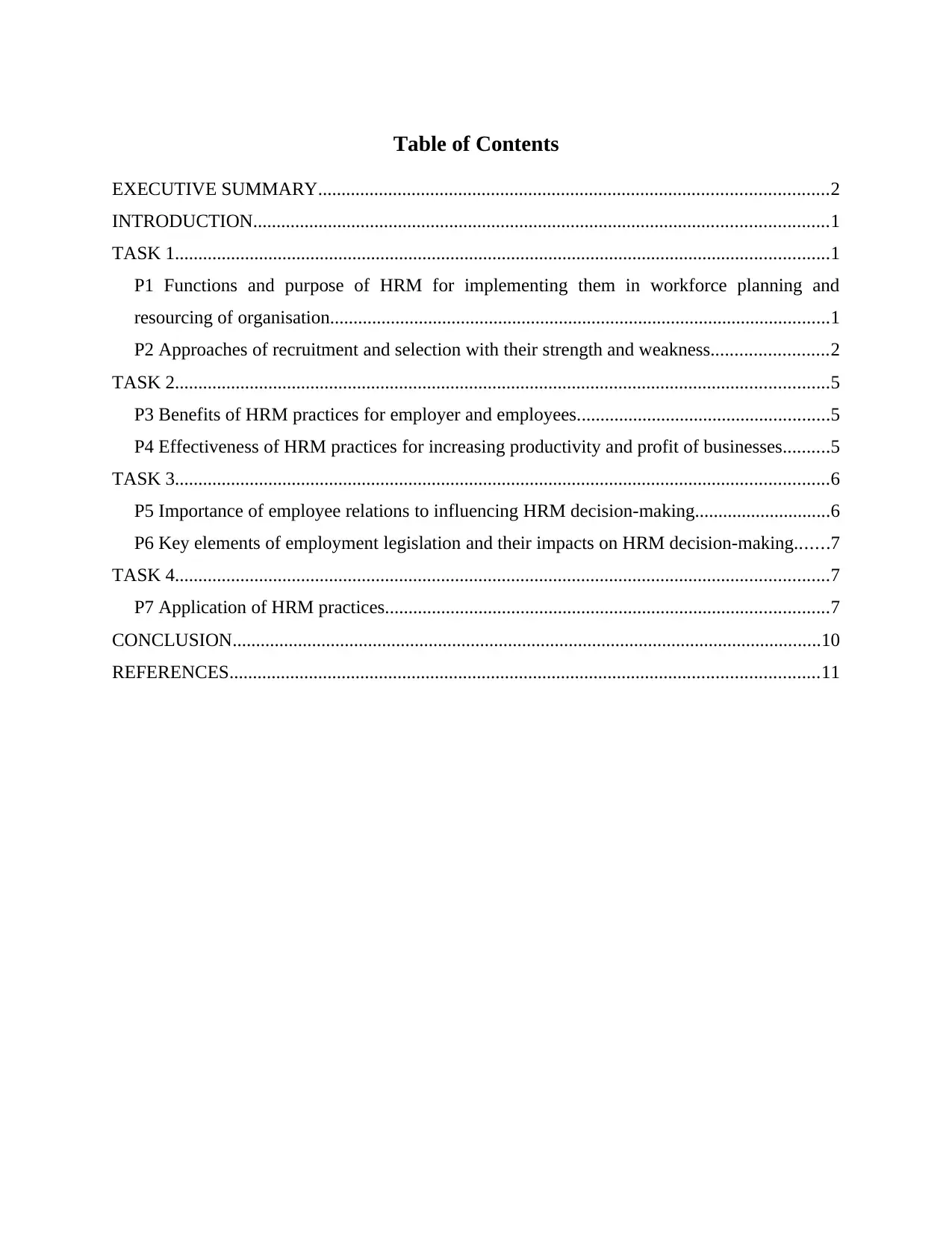
Table of Contents
EXECUTIVE SUMMARY.............................................................................................................2
INTRODUCTION...........................................................................................................................1
TASK 1............................................................................................................................................1
P1 Functions and purpose of HRM for implementing them in workforce planning and
resourcing of organisation...........................................................................................................1
P2 Approaches of recruitment and selection with their strength and weakness.........................2
TASK 2............................................................................................................................................5
P3 Benefits of HRM practices for employer and employees......................................................5
P4 Effectiveness of HRM practices for increasing productivity and profit of businesses..........5
TASK 3............................................................................................................................................6
P5 Importance of employee relations to influencing HRM decision-making.............................6
P6 Key elements of employment legislation and their impacts on HRM decision-making.......7
TASK 4............................................................................................................................................7
P7 Application of HRM practices...............................................................................................7
CONCLUSION..............................................................................................................................10
REFERENCES..............................................................................................................................11
EXECUTIVE SUMMARY.............................................................................................................2
INTRODUCTION...........................................................................................................................1
TASK 1............................................................................................................................................1
P1 Functions and purpose of HRM for implementing them in workforce planning and
resourcing of organisation...........................................................................................................1
P2 Approaches of recruitment and selection with their strength and weakness.........................2
TASK 2............................................................................................................................................5
P3 Benefits of HRM practices for employer and employees......................................................5
P4 Effectiveness of HRM practices for increasing productivity and profit of businesses..........5
TASK 3............................................................................................................................................6
P5 Importance of employee relations to influencing HRM decision-making.............................6
P6 Key elements of employment legislation and their impacts on HRM decision-making.......7
TASK 4............................................................................................................................................7
P7 Application of HRM practices...............................................................................................7
CONCLUSION..............................................................................................................................10
REFERENCES..............................................................................................................................11
⊘ This is a preview!⊘
Do you want full access?
Subscribe today to unlock all pages.

Trusted by 1+ million students worldwide
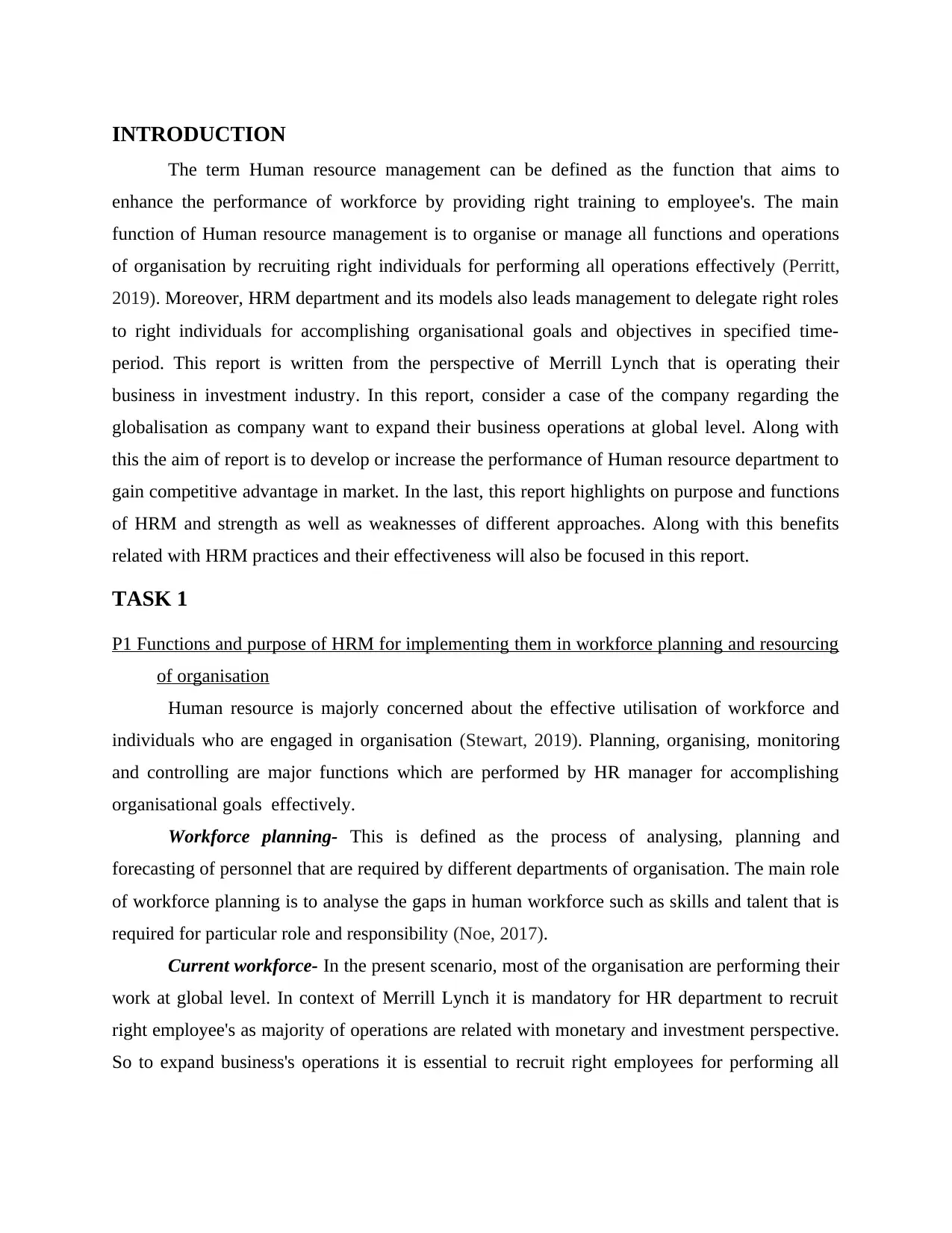
INTRODUCTION
The term Human resource management can be defined as the function that aims to
enhance the performance of workforce by providing right training to employee's. The main
function of Human resource management is to organise or manage all functions and operations
of organisation by recruiting right individuals for performing all operations effectively (Perritt,
2019). Moreover, HRM department and its models also leads management to delegate right roles
to right individuals for accomplishing organisational goals and objectives in specified time-
period. This report is written from the perspective of Merrill Lynch that is operating their
business in investment industry. In this report, consider a case of the company regarding the
globalisation as company want to expand their business operations at global level. Along with
this the aim of report is to develop or increase the performance of Human resource department to
gain competitive advantage in market. In the last, this report highlights on purpose and functions
of HRM and strength as well as weaknesses of different approaches. Along with this benefits
related with HRM practices and their effectiveness will also be focused in this report.
TASK 1
P1 Functions and purpose of HRM for implementing them in workforce planning and resourcing
of organisation
Human resource is majorly concerned about the effective utilisation of workforce and
individuals who are engaged in organisation (Stewart, 2019). Planning, organising, monitoring
and controlling are major functions which are performed by HR manager for accomplishing
organisational goals effectively.
Workforce planning- This is defined as the process of analysing, planning and
forecasting of personnel that are required by different departments of organisation. The main role
of workforce planning is to analyse the gaps in human workforce such as skills and talent that is
required for particular role and responsibility (Noe, 2017).
Current workforce- In the present scenario, most of the organisation are performing their
work at global level. In context of Merrill Lynch it is mandatory for HR department to recruit
right employee's as majority of operations are related with monetary and investment perspective.
So to expand business's operations it is essential to recruit right employees for performing all
The term Human resource management can be defined as the function that aims to
enhance the performance of workforce by providing right training to employee's. The main
function of Human resource management is to organise or manage all functions and operations
of organisation by recruiting right individuals for performing all operations effectively (Perritt,
2019). Moreover, HRM department and its models also leads management to delegate right roles
to right individuals for accomplishing organisational goals and objectives in specified time-
period. This report is written from the perspective of Merrill Lynch that is operating their
business in investment industry. In this report, consider a case of the company regarding the
globalisation as company want to expand their business operations at global level. Along with
this the aim of report is to develop or increase the performance of Human resource department to
gain competitive advantage in market. In the last, this report highlights on purpose and functions
of HRM and strength as well as weaknesses of different approaches. Along with this benefits
related with HRM practices and their effectiveness will also be focused in this report.
TASK 1
P1 Functions and purpose of HRM for implementing them in workforce planning and resourcing
of organisation
Human resource is majorly concerned about the effective utilisation of workforce and
individuals who are engaged in organisation (Stewart, 2019). Planning, organising, monitoring
and controlling are major functions which are performed by HR manager for accomplishing
organisational goals effectively.
Workforce planning- This is defined as the process of analysing, planning and
forecasting of personnel that are required by different departments of organisation. The main role
of workforce planning is to analyse the gaps in human workforce such as skills and talent that is
required for particular role and responsibility (Noe, 2017).
Current workforce- In the present scenario, most of the organisation are performing their
work at global level. In context of Merrill Lynch it is mandatory for HR department to recruit
right employee's as majority of operations are related with monetary and investment perspective.
So to expand business's operations it is essential to recruit right employees for performing all
Paraphrase This Document
Need a fresh take? Get an instant paraphrase of this document with our AI Paraphraser
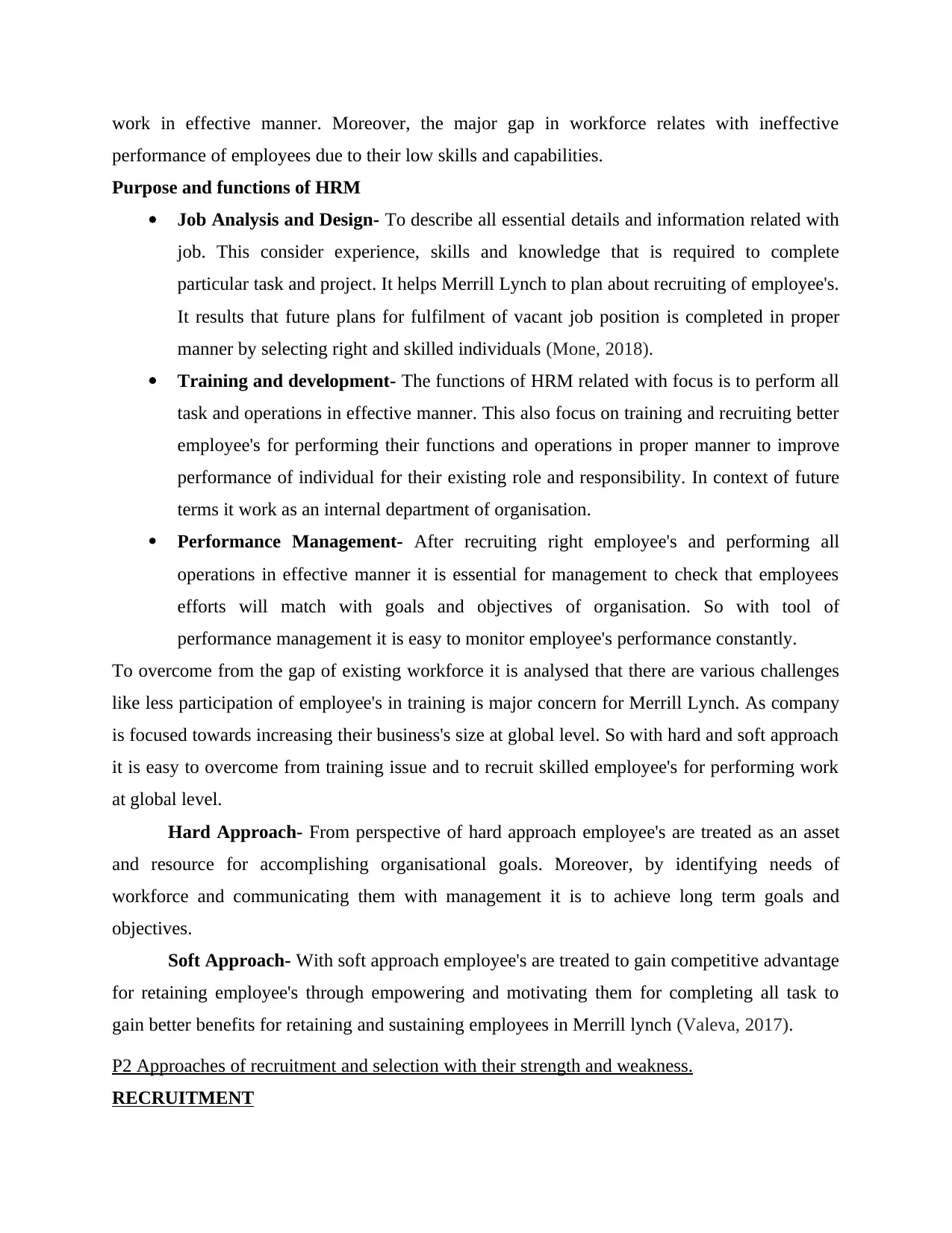
work in effective manner. Moreover, the major gap in workforce relates with ineffective
performance of employees due to their low skills and capabilities.
Purpose and functions of HRM
Job Analysis and Design- To describe all essential details and information related with
job. This consider experience, skills and knowledge that is required to complete
particular task and project. It helps Merrill Lynch to plan about recruiting of employee's.
It results that future plans for fulfilment of vacant job position is completed in proper
manner by selecting right and skilled individuals (Mone, 2018).
Training and development- The functions of HRM related with focus is to perform all
task and operations in effective manner. This also focus on training and recruiting better
employee's for performing their functions and operations in proper manner to improve
performance of individual for their existing role and responsibility. In context of future
terms it work as an internal department of organisation.
Performance Management- After recruiting right employee's and performing all
operations in effective manner it is essential for management to check that employees
efforts will match with goals and objectives of organisation. So with tool of
performance management it is easy to monitor employee's performance constantly.
To overcome from the gap of existing workforce it is analysed that there are various challenges
like less participation of employee's in training is major concern for Merrill Lynch. As company
is focused towards increasing their business's size at global level. So with hard and soft approach
it is easy to overcome from training issue and to recruit skilled employee's for performing work
at global level.
Hard Approach- From perspective of hard approach employee's are treated as an asset
and resource for accomplishing organisational goals. Moreover, by identifying needs of
workforce and communicating them with management it is to achieve long term goals and
objectives.
Soft Approach- With soft approach employee's are treated to gain competitive advantage
for retaining employee's through empowering and motivating them for completing all task to
gain better benefits for retaining and sustaining employees in Merrill lynch (Valeva, 2017).
P2 Approaches of recruitment and selection with their strength and weakness.
RECRUITMENT
performance of employees due to their low skills and capabilities.
Purpose and functions of HRM
Job Analysis and Design- To describe all essential details and information related with
job. This consider experience, skills and knowledge that is required to complete
particular task and project. It helps Merrill Lynch to plan about recruiting of employee's.
It results that future plans for fulfilment of vacant job position is completed in proper
manner by selecting right and skilled individuals (Mone, 2018).
Training and development- The functions of HRM related with focus is to perform all
task and operations in effective manner. This also focus on training and recruiting better
employee's for performing their functions and operations in proper manner to improve
performance of individual for their existing role and responsibility. In context of future
terms it work as an internal department of organisation.
Performance Management- After recruiting right employee's and performing all
operations in effective manner it is essential for management to check that employees
efforts will match with goals and objectives of organisation. So with tool of
performance management it is easy to monitor employee's performance constantly.
To overcome from the gap of existing workforce it is analysed that there are various challenges
like less participation of employee's in training is major concern for Merrill Lynch. As company
is focused towards increasing their business's size at global level. So with hard and soft approach
it is easy to overcome from training issue and to recruit skilled employee's for performing work
at global level.
Hard Approach- From perspective of hard approach employee's are treated as an asset
and resource for accomplishing organisational goals. Moreover, by identifying needs of
workforce and communicating them with management it is to achieve long term goals and
objectives.
Soft Approach- With soft approach employee's are treated to gain competitive advantage
for retaining employee's through empowering and motivating them for completing all task to
gain better benefits for retaining and sustaining employees in Merrill lynch (Valeva, 2017).
P2 Approaches of recruitment and selection with their strength and weakness.
RECRUITMENT
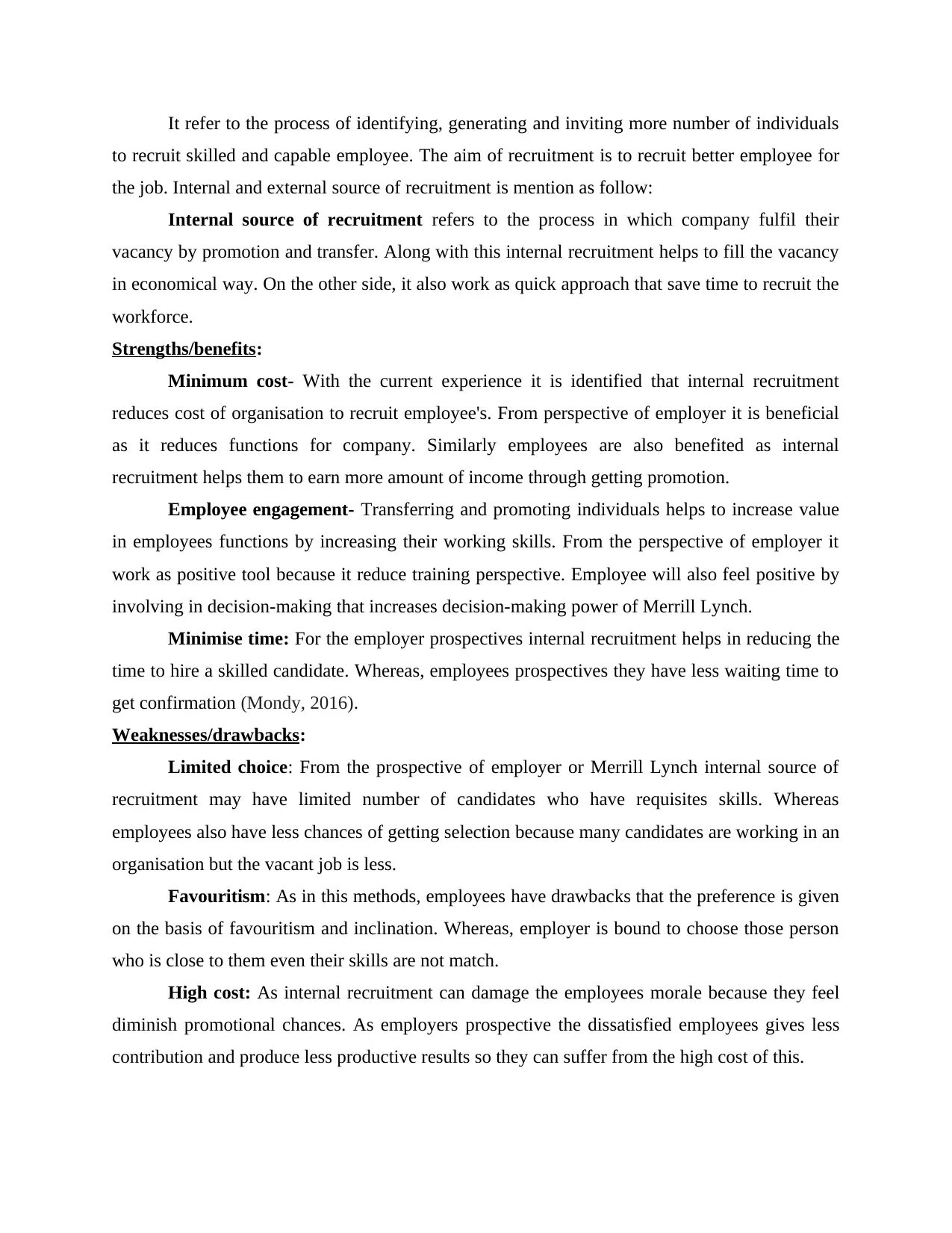
It refer to the process of identifying, generating and inviting more number of individuals
to recruit skilled and capable employee. The aim of recruitment is to recruit better employee for
the job. Internal and external source of recruitment is mention as follow:
Internal source of recruitment refers to the process in which company fulfil their
vacancy by promotion and transfer. Along with this internal recruitment helps to fill the vacancy
in economical way. On the other side, it also work as quick approach that save time to recruit the
workforce.
Strengths/benefits:
Minimum cost- With the current experience it is identified that internal recruitment
reduces cost of organisation to recruit employee's. From perspective of employer it is beneficial
as it reduces functions for company. Similarly employees are also benefited as internal
recruitment helps them to earn more amount of income through getting promotion.
Employee engagement- Transferring and promoting individuals helps to increase value
in employees functions by increasing their working skills. From the perspective of employer it
work as positive tool because it reduce training perspective. Employee will also feel positive by
involving in decision-making that increases decision-making power of Merrill Lynch.
Minimise time: For the employer prospectives internal recruitment helps in reducing the
time to hire a skilled candidate. Whereas, employees prospectives they have less waiting time to
get confirmation (Mondy, 2016).
Weaknesses/drawbacks:
Limited choice: From the prospective of employer or Merrill Lynch internal source of
recruitment may have limited number of candidates who have requisites skills. Whereas
employees also have less chances of getting selection because many candidates are working in an
organisation but the vacant job is less.
Favouritism: As in this methods, employees have drawbacks that the preference is given
on the basis of favouritism and inclination. Whereas, employer is bound to choose those person
who is close to them even their skills are not match.
High cost: As internal recruitment can damage the employees morale because they feel
diminish promotional chances. As employers prospective the dissatisfied employees gives less
contribution and produce less productive results so they can suffer from the high cost of this.
to recruit skilled and capable employee. The aim of recruitment is to recruit better employee for
the job. Internal and external source of recruitment is mention as follow:
Internal source of recruitment refers to the process in which company fulfil their
vacancy by promotion and transfer. Along with this internal recruitment helps to fill the vacancy
in economical way. On the other side, it also work as quick approach that save time to recruit the
workforce.
Strengths/benefits:
Minimum cost- With the current experience it is identified that internal recruitment
reduces cost of organisation to recruit employee's. From perspective of employer it is beneficial
as it reduces functions for company. Similarly employees are also benefited as internal
recruitment helps them to earn more amount of income through getting promotion.
Employee engagement- Transferring and promoting individuals helps to increase value
in employees functions by increasing their working skills. From the perspective of employer it
work as positive tool because it reduce training perspective. Employee will also feel positive by
involving in decision-making that increases decision-making power of Merrill Lynch.
Minimise time: For the employer prospectives internal recruitment helps in reducing the
time to hire a skilled candidate. Whereas, employees prospectives they have less waiting time to
get confirmation (Mondy, 2016).
Weaknesses/drawbacks:
Limited choice: From the prospective of employer or Merrill Lynch internal source of
recruitment may have limited number of candidates who have requisites skills. Whereas
employees also have less chances of getting selection because many candidates are working in an
organisation but the vacant job is less.
Favouritism: As in this methods, employees have drawbacks that the preference is given
on the basis of favouritism and inclination. Whereas, employer is bound to choose those person
who is close to them even their skills are not match.
High cost: As internal recruitment can damage the employees morale because they feel
diminish promotional chances. As employers prospective the dissatisfied employees gives less
contribution and produce less productive results so they can suffer from the high cost of this.
⊘ This is a preview!⊘
Do you want full access?
Subscribe today to unlock all pages.

Trusted by 1+ million students worldwide
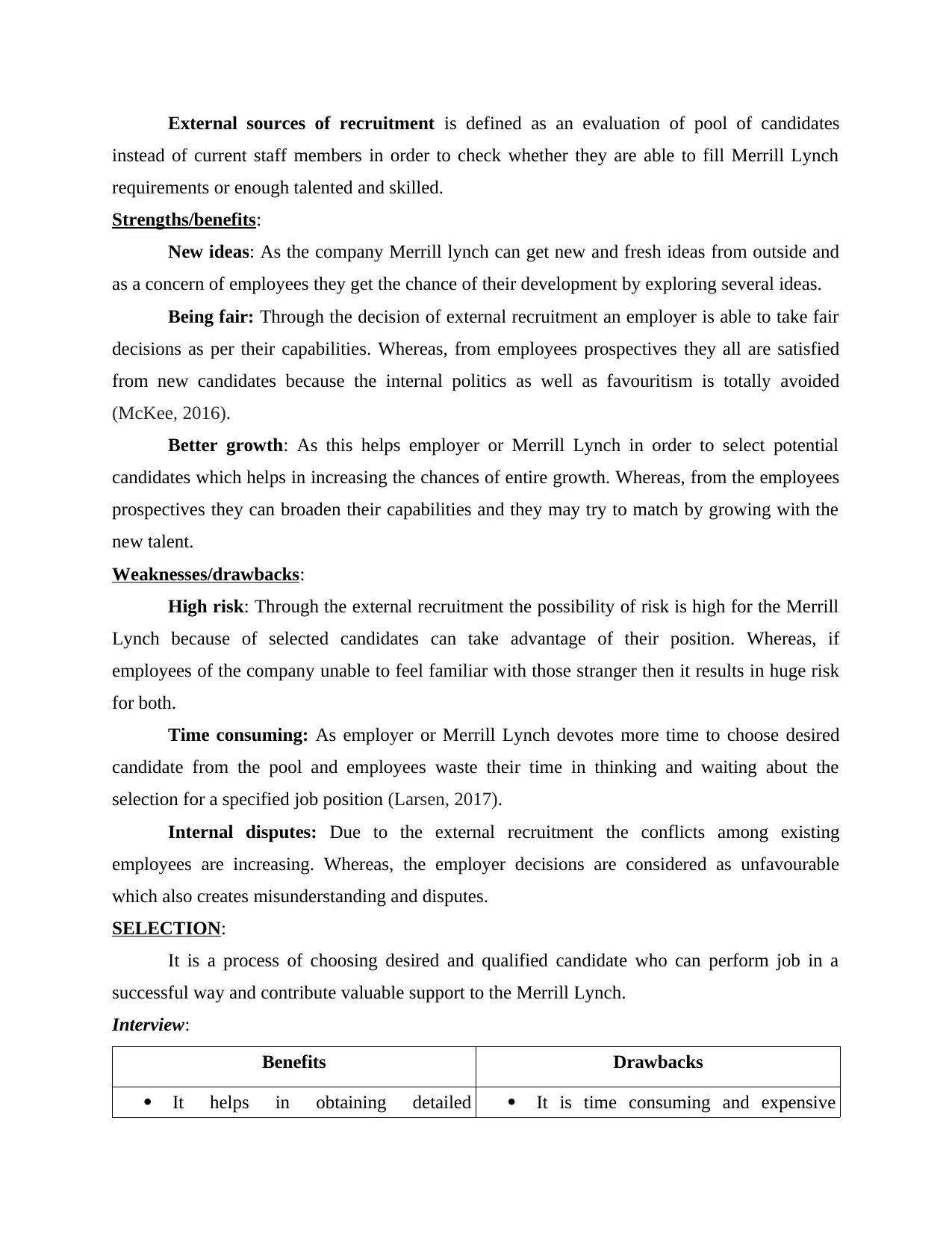
External sources of recruitment is defined as an evaluation of pool of candidates
instead of current staff members in order to check whether they are able to fill Merrill Lynch
requirements or enough talented and skilled.
Strengths/benefits:
New ideas: As the company Merrill lynch can get new and fresh ideas from outside and
as a concern of employees they get the chance of their development by exploring several ideas.
Being fair: Through the decision of external recruitment an employer is able to take fair
decisions as per their capabilities. Whereas, from employees prospectives they all are satisfied
from new candidates because the internal politics as well as favouritism is totally avoided
(McKee, 2016).
Better growth: As this helps employer or Merrill Lynch in order to select potential
candidates which helps in increasing the chances of entire growth. Whereas, from the employees
prospectives they can broaden their capabilities and they may try to match by growing with the
new talent.
Weaknesses/drawbacks:
High risk: Through the external recruitment the possibility of risk is high for the Merrill
Lynch because of selected candidates can take advantage of their position. Whereas, if
employees of the company unable to feel familiar with those stranger then it results in huge risk
for both.
Time consuming: As employer or Merrill Lynch devotes more time to choose desired
candidate from the pool and employees waste their time in thinking and waiting about the
selection for a specified job position (Larsen, 2017).
Internal disputes: Due to the external recruitment the conflicts among existing
employees are increasing. Whereas, the employer decisions are considered as unfavourable
which also creates misunderstanding and disputes.
SELECTION:
It is a process of choosing desired and qualified candidate who can perform job in a
successful way and contribute valuable support to the Merrill Lynch.
Interview:
Benefits Drawbacks
It helps in obtaining detailed It is time consuming and expensive
instead of current staff members in order to check whether they are able to fill Merrill Lynch
requirements or enough talented and skilled.
Strengths/benefits:
New ideas: As the company Merrill lynch can get new and fresh ideas from outside and
as a concern of employees they get the chance of their development by exploring several ideas.
Being fair: Through the decision of external recruitment an employer is able to take fair
decisions as per their capabilities. Whereas, from employees prospectives they all are satisfied
from new candidates because the internal politics as well as favouritism is totally avoided
(McKee, 2016).
Better growth: As this helps employer or Merrill Lynch in order to select potential
candidates which helps in increasing the chances of entire growth. Whereas, from the employees
prospectives they can broaden their capabilities and they may try to match by growing with the
new talent.
Weaknesses/drawbacks:
High risk: Through the external recruitment the possibility of risk is high for the Merrill
Lynch because of selected candidates can take advantage of their position. Whereas, if
employees of the company unable to feel familiar with those stranger then it results in huge risk
for both.
Time consuming: As employer or Merrill Lynch devotes more time to choose desired
candidate from the pool and employees waste their time in thinking and waiting about the
selection for a specified job position (Larsen, 2017).
Internal disputes: Due to the external recruitment the conflicts among existing
employees are increasing. Whereas, the employer decisions are considered as unfavourable
which also creates misunderstanding and disputes.
SELECTION:
It is a process of choosing desired and qualified candidate who can perform job in a
successful way and contribute valuable support to the Merrill Lynch.
Interview:
Benefits Drawbacks
It helps in obtaining detailed It is time consuming and expensive
Paraphrase This Document
Need a fresh take? Get an instant paraphrase of this document with our AI Paraphraser
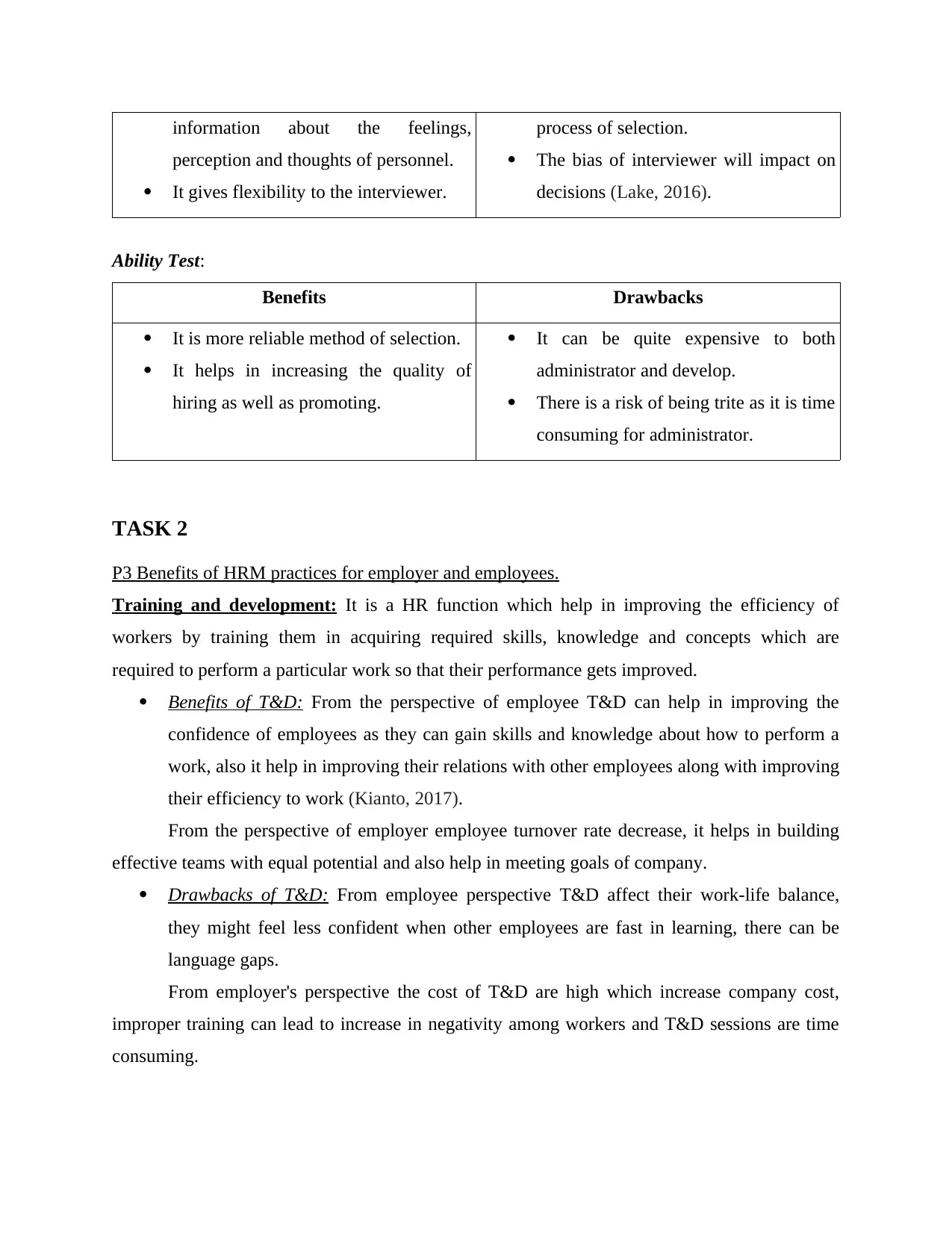
information about the feelings,
perception and thoughts of personnel.
It gives flexibility to the interviewer.
process of selection.
The bias of interviewer will impact on
decisions (Lake, 2016).
Ability Test:
Benefits Drawbacks
It is more reliable method of selection.
It helps in increasing the quality of
hiring as well as promoting.
It can be quite expensive to both
administrator and develop.
There is a risk of being trite as it is time
consuming for administrator.
TASK 2
P3 Benefits of HRM practices for employer and employees.
Training and development: It is a HR function which help in improving the efficiency of
workers by training them in acquiring required skills, knowledge and concepts which are
required to perform a particular work so that their performance gets improved.
Benefits of T&D: From the perspective of employee T&D can help in improving the
confidence of employees as they can gain skills and knowledge about how to perform a
work, also it help in improving their relations with other employees along with improving
their efficiency to work (Kianto, 2017).
From the perspective of employer employee turnover rate decrease, it helps in building
effective teams with equal potential and also help in meeting goals of company.
Drawbacks of T&D: From employee perspective T&D affect their work-life balance,
they might feel less confident when other employees are fast in learning, there can be
language gaps.
From employer's perspective the cost of T&D are high which increase company cost,
improper training can lead to increase in negativity among workers and T&D sessions are time
consuming.
perception and thoughts of personnel.
It gives flexibility to the interviewer.
process of selection.
The bias of interviewer will impact on
decisions (Lake, 2016).
Ability Test:
Benefits Drawbacks
It is more reliable method of selection.
It helps in increasing the quality of
hiring as well as promoting.
It can be quite expensive to both
administrator and develop.
There is a risk of being trite as it is time
consuming for administrator.
TASK 2
P3 Benefits of HRM practices for employer and employees.
Training and development: It is a HR function which help in improving the efficiency of
workers by training them in acquiring required skills, knowledge and concepts which are
required to perform a particular work so that their performance gets improved.
Benefits of T&D: From the perspective of employee T&D can help in improving the
confidence of employees as they can gain skills and knowledge about how to perform a
work, also it help in improving their relations with other employees along with improving
their efficiency to work (Kianto, 2017).
From the perspective of employer employee turnover rate decrease, it helps in building
effective teams with equal potential and also help in meeting goals of company.
Drawbacks of T&D: From employee perspective T&D affect their work-life balance,
they might feel less confident when other employees are fast in learning, there can be
language gaps.
From employer's perspective the cost of T&D are high which increase company cost,
improper training can lead to increase in negativity among workers and T&D sessions are time
consuming.
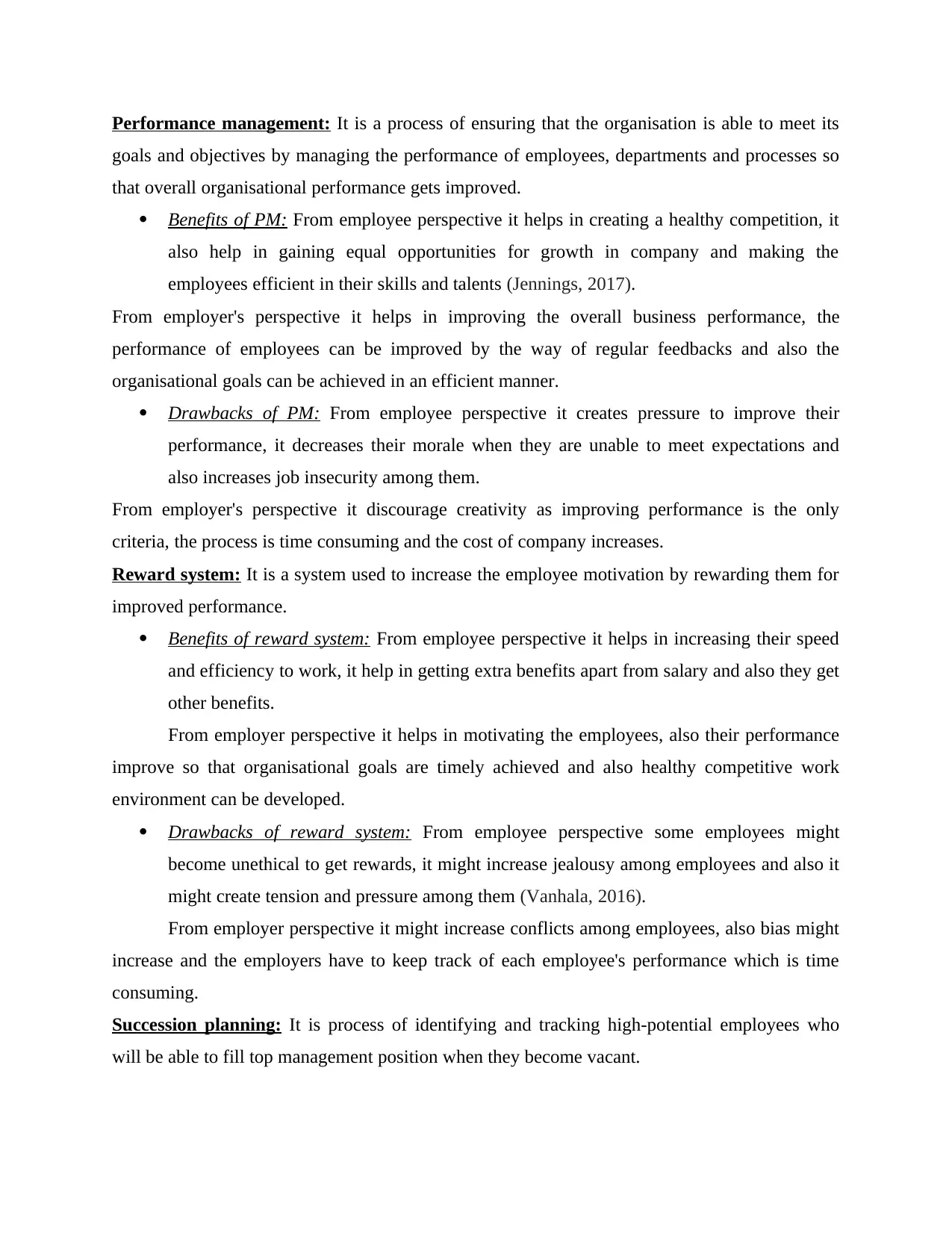
Performance management: It is a process of ensuring that the organisation is able to meet its
goals and objectives by managing the performance of employees, departments and processes so
that overall organisational performance gets improved.
Benefits of PM: From employee perspective it helps in creating a healthy competition, it
also help in gaining equal opportunities for growth in company and making the
employees efficient in their skills and talents (Jennings, 2017).
From employer's perspective it helps in improving the overall business performance, the
performance of employees can be improved by the way of regular feedbacks and also the
organisational goals can be achieved in an efficient manner.
Drawbacks of PM: From employee perspective it creates pressure to improve their
performance, it decreases their morale when they are unable to meet expectations and
also increases job insecurity among them.
From employer's perspective it discourage creativity as improving performance is the only
criteria, the process is time consuming and the cost of company increases.
Reward system: It is a system used to increase the employee motivation by rewarding them for
improved performance.
Benefits of reward system: From employee perspective it helps in increasing their speed
and efficiency to work, it help in getting extra benefits apart from salary and also they get
other benefits.
From employer perspective it helps in motivating the employees, also their performance
improve so that organisational goals are timely achieved and also healthy competitive work
environment can be developed.
Drawbacks of reward system: From employee perspective some employees might
become unethical to get rewards, it might increase jealousy among employees and also it
might create tension and pressure among them (Vanhala, 2016).
From employer perspective it might increase conflicts among employees, also bias might
increase and the employers have to keep track of each employee's performance which is time
consuming.
Succession planning: It is process of identifying and tracking high-potential employees who
will be able to fill top management position when they become vacant.
goals and objectives by managing the performance of employees, departments and processes so
that overall organisational performance gets improved.
Benefits of PM: From employee perspective it helps in creating a healthy competition, it
also help in gaining equal opportunities for growth in company and making the
employees efficient in their skills and talents (Jennings, 2017).
From employer's perspective it helps in improving the overall business performance, the
performance of employees can be improved by the way of regular feedbacks and also the
organisational goals can be achieved in an efficient manner.
Drawbacks of PM: From employee perspective it creates pressure to improve their
performance, it decreases their morale when they are unable to meet expectations and
also increases job insecurity among them.
From employer's perspective it discourage creativity as improving performance is the only
criteria, the process is time consuming and the cost of company increases.
Reward system: It is a system used to increase the employee motivation by rewarding them for
improved performance.
Benefits of reward system: From employee perspective it helps in increasing their speed
and efficiency to work, it help in getting extra benefits apart from salary and also they get
other benefits.
From employer perspective it helps in motivating the employees, also their performance
improve so that organisational goals are timely achieved and also healthy competitive work
environment can be developed.
Drawbacks of reward system: From employee perspective some employees might
become unethical to get rewards, it might increase jealousy among employees and also it
might create tension and pressure among them (Vanhala, 2016).
From employer perspective it might increase conflicts among employees, also bias might
increase and the employers have to keep track of each employee's performance which is time
consuming.
Succession planning: It is process of identifying and tracking high-potential employees who
will be able to fill top management position when they become vacant.
⊘ This is a preview!⊘
Do you want full access?
Subscribe today to unlock all pages.

Trusted by 1+ million students worldwide
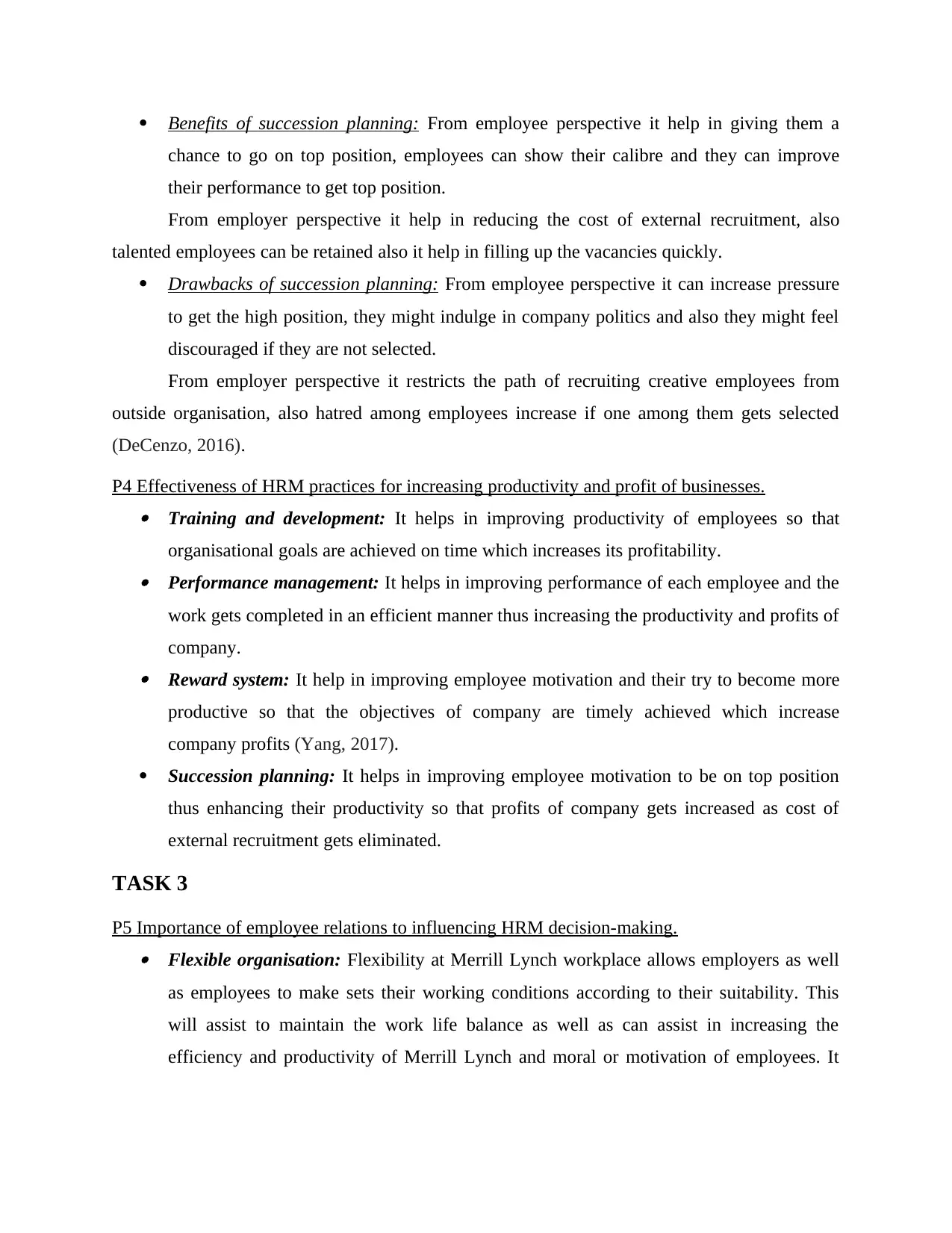
Benefits of succession planning: From employee perspective it help in giving them a
chance to go on top position, employees can show their calibre and they can improve
their performance to get top position.
From employer perspective it help in reducing the cost of external recruitment, also
talented employees can be retained also it help in filling up the vacancies quickly.
Drawbacks of succession planning: From employee perspective it can increase pressure
to get the high position, they might indulge in company politics and also they might feel
discouraged if they are not selected.
From employer perspective it restricts the path of recruiting creative employees from
outside organisation, also hatred among employees increase if one among them gets selected
(DeCenzo, 2016).
P4 Effectiveness of HRM practices for increasing productivity and profit of businesses. Training and development: It helps in improving productivity of employees so that
organisational goals are achieved on time which increases its profitability. Performance management: It helps in improving performance of each employee and the
work gets completed in an efficient manner thus increasing the productivity and profits of
company. Reward system: It help in improving employee motivation and their try to become more
productive so that the objectives of company are timely achieved which increase
company profits (Yang, 2017).
Succession planning: It helps in improving employee motivation to be on top position
thus enhancing their productivity so that profits of company gets increased as cost of
external recruitment gets eliminated.
TASK 3
P5 Importance of employee relations to influencing HRM decision-making. Flexible organisation: Flexibility at Merrill Lynch workplace allows employers as well
as employees to make sets their working conditions according to their suitability. This
will assist to maintain the work life balance as well as can assist in increasing the
efficiency and productivity of Merrill Lynch and moral or motivation of employees. It
chance to go on top position, employees can show their calibre and they can improve
their performance to get top position.
From employer perspective it help in reducing the cost of external recruitment, also
talented employees can be retained also it help in filling up the vacancies quickly.
Drawbacks of succession planning: From employee perspective it can increase pressure
to get the high position, they might indulge in company politics and also they might feel
discouraged if they are not selected.
From employer perspective it restricts the path of recruiting creative employees from
outside organisation, also hatred among employees increase if one among them gets selected
(DeCenzo, 2016).
P4 Effectiveness of HRM practices for increasing productivity and profit of businesses. Training and development: It helps in improving productivity of employees so that
organisational goals are achieved on time which increases its profitability. Performance management: It helps in improving performance of each employee and the
work gets completed in an efficient manner thus increasing the productivity and profits of
company. Reward system: It help in improving employee motivation and their try to become more
productive so that the objectives of company are timely achieved which increase
company profits (Yang, 2017).
Succession planning: It helps in improving employee motivation to be on top position
thus enhancing their productivity so that profits of company gets increased as cost of
external recruitment gets eliminated.
TASK 3
P5 Importance of employee relations to influencing HRM decision-making. Flexible organisation: Flexibility at Merrill Lynch workplace allows employers as well
as employees to make sets their working conditions according to their suitability. This
will assist to maintain the work life balance as well as can assist in increasing the
efficiency and productivity of Merrill Lynch and moral or motivation of employees. It
Paraphrase This Document
Need a fresh take? Get an instant paraphrase of this document with our AI Paraphraser
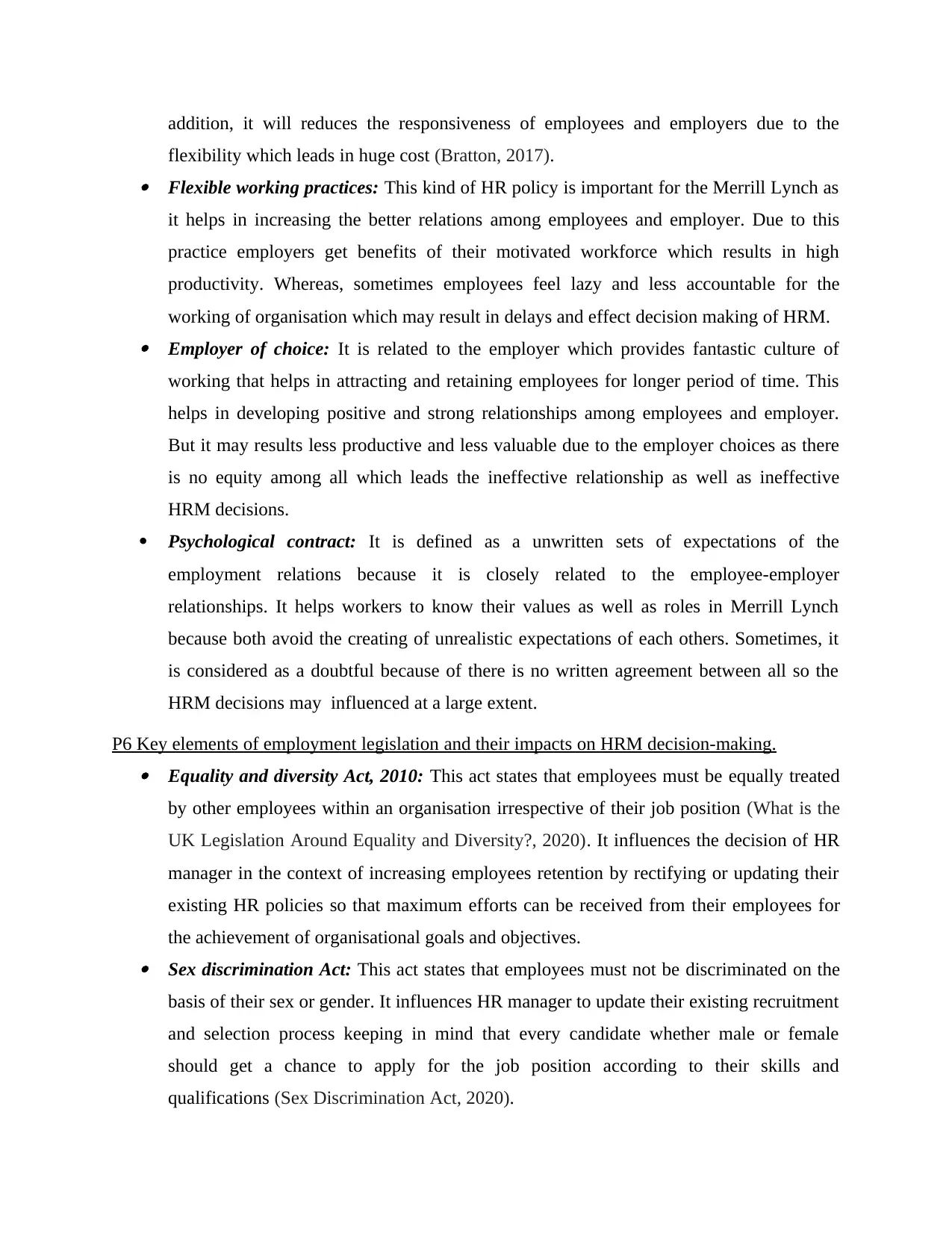
addition, it will reduces the responsiveness of employees and employers due to the
flexibility which leads in huge cost (Bratton, 2017). Flexible working practices: This kind of HR policy is important for the Merrill Lynch as
it helps in increasing the better relations among employees and employer. Due to this
practice employers get benefits of their motivated workforce which results in high
productivity. Whereas, sometimes employees feel lazy and less accountable for the
working of organisation which may result in delays and effect decision making of HRM. Employer of choice: It is related to the employer which provides fantastic culture of
working that helps in attracting and retaining employees for longer period of time. This
helps in developing positive and strong relationships among employees and employer.
But it may results less productive and less valuable due to the employer choices as there
is no equity among all which leads the ineffective relationship as well as ineffective
HRM decisions.
Psychological contract: It is defined as a unwritten sets of expectations of the
employment relations because it is closely related to the employee-employer
relationships. It helps workers to know their values as well as roles in Merrill Lynch
because both avoid the creating of unrealistic expectations of each others. Sometimes, it
is considered as a doubtful because of there is no written agreement between all so the
HRM decisions may influenced at a large extent.
P6 Key elements of employment legislation and their impacts on HRM decision-making. Equality and diversity Act, 2010: This act states that employees must be equally treated
by other employees within an organisation irrespective of their job position (What is the
UK Legislation Around Equality and Diversity?, 2020). It influences the decision of HR
manager in the context of increasing employees retention by rectifying or updating their
existing HR policies so that maximum efforts can be received from their employees for
the achievement of organisational goals and objectives. Sex discrimination Act: This act states that employees must not be discriminated on the
basis of their sex or gender. It influences HR manager to update their existing recruitment
and selection process keeping in mind that every candidate whether male or female
should get a chance to apply for the job position according to their skills and
qualifications (Sex Discrimination Act, 2020).
flexibility which leads in huge cost (Bratton, 2017). Flexible working practices: This kind of HR policy is important for the Merrill Lynch as
it helps in increasing the better relations among employees and employer. Due to this
practice employers get benefits of their motivated workforce which results in high
productivity. Whereas, sometimes employees feel lazy and less accountable for the
working of organisation which may result in delays and effect decision making of HRM. Employer of choice: It is related to the employer which provides fantastic culture of
working that helps in attracting and retaining employees for longer period of time. This
helps in developing positive and strong relationships among employees and employer.
But it may results less productive and less valuable due to the employer choices as there
is no equity among all which leads the ineffective relationship as well as ineffective
HRM decisions.
Psychological contract: It is defined as a unwritten sets of expectations of the
employment relations because it is closely related to the employee-employer
relationships. It helps workers to know their values as well as roles in Merrill Lynch
because both avoid the creating of unrealistic expectations of each others. Sometimes, it
is considered as a doubtful because of there is no written agreement between all so the
HRM decisions may influenced at a large extent.
P6 Key elements of employment legislation and their impacts on HRM decision-making. Equality and diversity Act, 2010: This act states that employees must be equally treated
by other employees within an organisation irrespective of their job position (What is the
UK Legislation Around Equality and Diversity?, 2020). It influences the decision of HR
manager in the context of increasing employees retention by rectifying or updating their
existing HR policies so that maximum efforts can be received from their employees for
the achievement of organisational goals and objectives. Sex discrimination Act: This act states that employees must not be discriminated on the
basis of their sex or gender. It influences HR manager to update their existing recruitment
and selection process keeping in mind that every candidate whether male or female
should get a chance to apply for the job position according to their skills and
qualifications (Sex Discrimination Act, 2020).
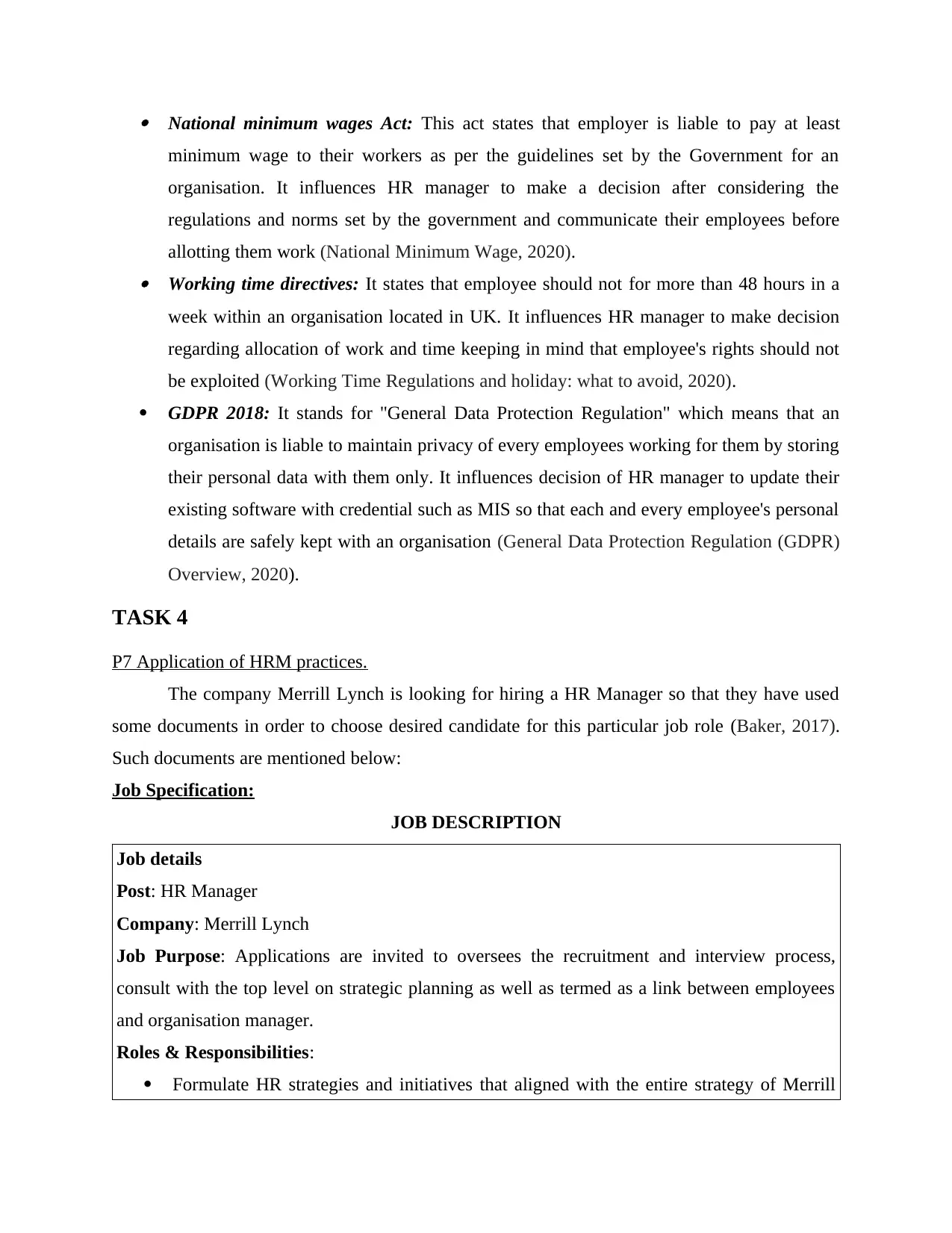
National minimum wages Act: This act states that employer is liable to pay at least
minimum wage to their workers as per the guidelines set by the Government for an
organisation. It influences HR manager to make a decision after considering the
regulations and norms set by the government and communicate their employees before
allotting them work (National Minimum Wage, 2020). Working time directives: It states that employee should not for more than 48 hours in a
week within an organisation located in UK. It influences HR manager to make decision
regarding allocation of work and time keeping in mind that employee's rights should not
be exploited (Working Time Regulations and holiday: what to avoid, 2020).
GDPR 2018: It stands for "General Data Protection Regulation" which means that an
organisation is liable to maintain privacy of every employees working for them by storing
their personal data with them only. It influences decision of HR manager to update their
existing software with credential such as MIS so that each and every employee's personal
details are safely kept with an organisation (General Data Protection Regulation (GDPR)
Overview, 2020).
TASK 4
P7 Application of HRM practices.
The company Merrill Lynch is looking for hiring a HR Manager so that they have used
some documents in order to choose desired candidate for this particular job role (Baker, 2017).
Such documents are mentioned below:
Job Specification:
JOB DESCRIPTION
Job details
Post: HR Manager
Company: Merrill Lynch
Job Purpose: Applications are invited to oversees the recruitment and interview process,
consult with the top level on strategic planning as well as termed as a link between employees
and organisation manager.
Roles & Responsibilities:
Formulate HR strategies and initiatives that aligned with the entire strategy of Merrill
minimum wage to their workers as per the guidelines set by the Government for an
organisation. It influences HR manager to make a decision after considering the
regulations and norms set by the government and communicate their employees before
allotting them work (National Minimum Wage, 2020). Working time directives: It states that employee should not for more than 48 hours in a
week within an organisation located in UK. It influences HR manager to make decision
regarding allocation of work and time keeping in mind that employee's rights should not
be exploited (Working Time Regulations and holiday: what to avoid, 2020).
GDPR 2018: It stands for "General Data Protection Regulation" which means that an
organisation is liable to maintain privacy of every employees working for them by storing
their personal data with them only. It influences decision of HR manager to update their
existing software with credential such as MIS so that each and every employee's personal
details are safely kept with an organisation (General Data Protection Regulation (GDPR)
Overview, 2020).
TASK 4
P7 Application of HRM practices.
The company Merrill Lynch is looking for hiring a HR Manager so that they have used
some documents in order to choose desired candidate for this particular job role (Baker, 2017).
Such documents are mentioned below:
Job Specification:
JOB DESCRIPTION
Job details
Post: HR Manager
Company: Merrill Lynch
Job Purpose: Applications are invited to oversees the recruitment and interview process,
consult with the top level on strategic planning as well as termed as a link between employees
and organisation manager.
Roles & Responsibilities:
Formulate HR strategies and initiatives that aligned with the entire strategy of Merrill
⊘ This is a preview!⊘
Do you want full access?
Subscribe today to unlock all pages.

Trusted by 1+ million students worldwide
1 out of 17
Related Documents
Your All-in-One AI-Powered Toolkit for Academic Success.
+13062052269
info@desklib.com
Available 24*7 on WhatsApp / Email
![[object Object]](/_next/static/media/star-bottom.7253800d.svg)
Unlock your academic potential
Copyright © 2020–2025 A2Z Services. All Rights Reserved. Developed and managed by ZUCOL.





